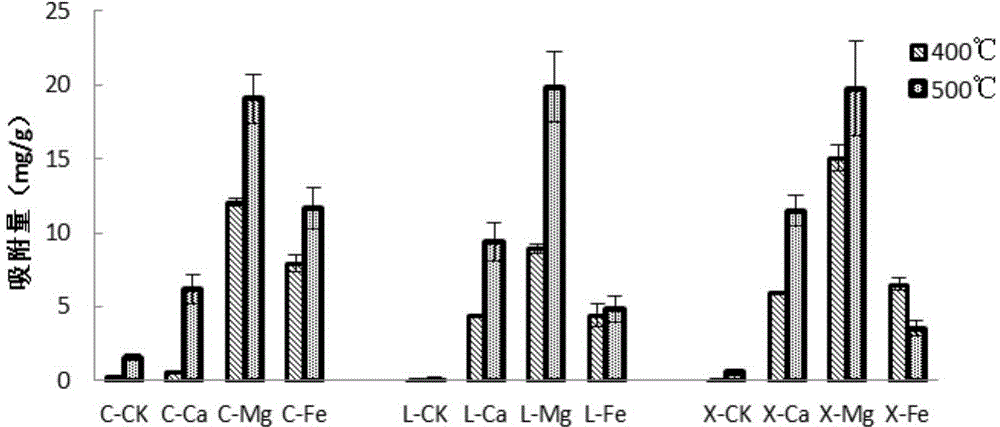Method for treating phosphatic sewage by coupling modified biomass charcoal and artificial wetland
A technology of biochar and artificial wetland, applied in sustainable biological treatment, biological water/sewage treatment, biofuel, etc., can solve problems such as being easily affected by climate temperature, achieve high economic value and ornamental value, and solve land occupation Large area, the effect of improving phosphorus removal efficiency
- Summary
- Abstract
- Description
- Claims
- Application Information
AI Technical Summary
Problems solved by technology
Method used
Image
Examples
Embodiment 1
[0032] From March to April 2012, 1 / 3 of the area of reed, calamus and cattail were planted on the soil layer of the constructed wetland. The pollen of cattails is collected from June to July. When the reeds and calamus are not completely withered and yellow in autumn, dig out the roots of the reeds, calamus and cattails, and make them into modified biochar. The specific steps are as follows:
[0033] (1) Air-drying and pulverizing the remainder of the aquatic plants into powder;
[0034] (2) the powder that step (1) obtains is in the MgCl that magnesium ion concentration is 0.8g / mL 2 Soak in 6H2O aqueous solution;
[0035] (3) Dry the mixed system obtained in step (2) first, then place it in a muffle furnace, keep it at 400-600°C (optimally stable at 500°C) for 1 hour, and cool to room temperature to obtain a carbonized product;
[0036] (4) Washing the carbonized product obtained in step (3) with water for 3 times, drying, grinding and passing through a 1 mm aperture sie...
Embodiment 2
[0039] Example 2: Determination of Phosphorus Removal Ability of Modified Biochar-Constructed Wetland
[0040] (1) select three kinds of aquatic plants of reed, calamus and cattail, air-dried and ground into powders with a diameter of about 2 mm, which are respectively recorded as l, C and K;
[0041] (2) The three powders in step (1) are equally divided into 4 parts, respectively in water, CaCl 2 Aqueous solution, MgCl2 6H2O aqueous solution and FeCl 3 Soak in aqueous solution for 2 hours to obtain C~CK, C~Ca, C~Mg, C~Fe, l~CK, l~Ca, l~Mg, l~Fe, X~CK, X~Ca, X~Mg and X~Fe12 group samples; wherein, the concentration of metal ions in the solution is 0.8g / mL;
[0042] (3) Dry each group of samples obtained in step (2) at 80°C, then divide them into 3 parts, put them into ceramic crucibles, wrap them with tinfoil paper after compaction and cover them, and put them in 400°C respectively , 500°C and 600°C muffle furnaces, kept for 1h, and cooled to room temperature to obtain carb...
Embodiment 3
[0048] Example 3: Modified biochar-constructed wetland coupled treatment of phosphorus-containing sewage
[0049] (1) Adopt the coupling system of biochar-underflow constructed wetland (such as Figure 4 ), the upper 30cm matrix is the filler layer, and the lower 10cm is the water-repellent layer, wherein the matrix in the filler layer is soil+quartz sand+modified biochar (the mass ratio of soil, quartz sand and modified biochar is 5:5:1 , the soil is conventional paddy field soil, quartz sand grain size 0.5cm), and evergreen aquatic iris is planted, with a density of 13 plants / m 2 .
[0050] (2) In the step (1), adopt the water flow mode of upper water outlet and lower water outlet, and the hydraulic retention time is 72h. ;
[0051](3) Measure the concentration of total phosphorus and dissolved phosphorus in the influent and effluent. The concentrations of total phosphorus and soluble inorganic phosphorus in the influent are 0.163mg / L and 0.093mg / L respectively, and the...
PUM
 Login to View More
Login to View More Abstract
Description
Claims
Application Information
 Login to View More
Login to View More - R&D Engineer
- R&D Manager
- IP Professional
- Industry Leading Data Capabilities
- Powerful AI technology
- Patent DNA Extraction
Browse by: Latest US Patents, China's latest patents, Technical Efficacy Thesaurus, Application Domain, Technology Topic, Popular Technical Reports.
© 2024 PatSnap. All rights reserved.Legal|Privacy policy|Modern Slavery Act Transparency Statement|Sitemap|About US| Contact US: help@patsnap.com










